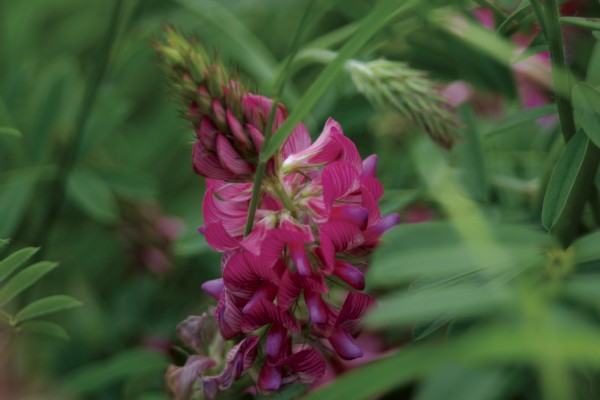

A silage or hay crop with grazing aftermath for dry, alkaline soils, there are few crops like sainfoin. It is a high-yielding, drought-resistant plant which needs no nitrogen fertiliser and little phosphate. It won’t cause bloat, is a natural anthelmintic and, with rumen protected protein, produces top quality meat and milk.
Sainfoin has deep penetrating roots making it highly suitable for the dry, alkaline soils of England. In these times of fluctuating feed and veterinary drugs prices, alongside increased environmental demands, there are few crops that tick as many boxes.
Forage legumes are attractive to farmers these days. Free nitrogen and extra protein content certainly meet current farming needs. Sainfoin offers this and a lot more besides. Until now there has been little information on sainfoin, but that is changing. The EU sainfoin research project known as ‘Healthy Hay’ is now completed and the results published online.
This was a four year project involving 12 partners from Europe. These include three from Britain: Reading University, NIAB and Cotswold Seeds. The network, which completed its work in 2010, has produced some interesting results. It seems that the role for sainfoin is about to be reinvented. In short, sainfoin offers farmers an attractive fodder crop for naturally alkaline, free draining soils. Some of the findings so far are detailed here.
Anthelmintic
Over the years we have heard from many of you about the remarkable effect that sainfoin has on wormy lambs. The ‘Healthy Hay’ project has demonstrated that the anti-parasitic benefits are very real indeed. Early results confirm that parasitic worm control is effective when sainfoin is fed as the worms' lifecycles are disrupted. Interestingly, there are some differences within sainfoin varieties which we may be able to take advantage of. These opportunities are to be explored further this year.
Protein, Animal Growth & Tannins
Protein, the essential element for growth, can be poorly utilised in ruminant animals as it can be rapidly broken down in the rumen. This is inefficient and leads to slower growth rates and increased nitrogen losses in the urine. Sainfoin contains tannins (complex chemical structures) which bind with protein molecules, protecting them as they pass through the rumen so that they can be absorbed efficiently as they pass further down the digestive tract. This doesn’t happen with other legumes and largely explains why stock fed sainfoin have faster liveweight gain when compared to any other forage.
Bloat Free & Methane
An animal blown up as a result of grazing clover is a distressing experience and is the main reason given by farmers for not growing legumes. Sainfoin never causes bloat, one of its great attributes. Recent work in Australia lead to the conclusion that as little as 20% of sainfoin in the diet can offset the risk of bloat to near zero. Work with beef steers in Canada showed the same when small quantities of sainfoin were mixed with lucerne. Rumen activity is important in other ways. From an environmental perspective the EU project has been studying rumen gas production with a particular interest in how sainfoin reduces methane production.
Roots, Soil & Drought
A sainfoin crop is capable of growing on the thinnest of alkaline soils. It is extremely drought-resistant and never stops growing even in prolonged dry spells. Its root structure leaves soil in excellent condition and sainfoin can be considered an invaluable part of the light land rotation. It penetrates soil and rock to a great depth where it seems able to extract nutrients better than any other species. It grows best on stony brash or chalks, but does not like wet soils where red clover should be chosen in preference. Sainfoin will grow well on alkaline soil and should not be sown on land below 6.2pH.
355 Sainfoins Collected
Almost one for every day of the year! From a plant breeding point of view, the ‘Healthy Hay’ project has been extremely productive. Through the involvement of NIAB a great number of sainfoin accessions have been collected. These have come from around the world and include some very interesting sub-species from Armenia. In total 170 have been planted, monitored and classified over the last three years. Now that the initial collection has been completed, it is hoped that this resource can be exploited by plant breeders. We are also compiling the results of biochemistry research which is providing helpful information on the effects of sainfoin on meat and milk quality. For full details of the work visit www.sainfoin.eu.
Date Posted: 30th March 2017



